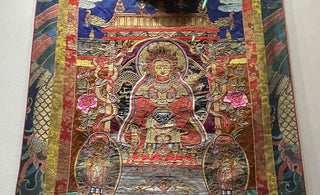
Introduction:
Thangka art, with its intricate details, vibrant colors, and profound spiritual symbolism, serves as a captivating window into Tibetan Buddhist culture. Rooted in ancient religious traditions, Thangka paintings not only showcase artistic mastery but also offer insights into the beliefs, values, and rituals of Tibetan Buddhism. This article explores the magical world of Thangka art, delving into its historical significance, the symbolism embedded within its imagery, and its role in preserving and promoting Tibetan Buddhist culture.
Historical Significance:
Thangka art holds deep historical significance within Tibetan Buddhist culture. Its origins can be traced back to the 7th century when Buddhism began to flourish in Tibet. Thangkas served as visual aids for meditation, providing practitioners with a visual representation of Buddhist deities, enlightened beings, and sacred texts. These portable artworks were often used during religious ceremonies and rituals and were revered as sacred objects.
Spiritual Symbolism:
Thangka paintings are not merely aesthetic creations; they are infused with profound spiritual symbolism. Each element within a Thangka carries symbolic meaning, carefully crafted to convey spiritual teachings. The central figure, often a deity or enlightened being, represents divine qualities and serves as a focal point for meditation. Surrounding the central figure are intricate depictions of mandalas, celestial beings, and other symbolic elements that represent the interconnectedness of the universe and the path to enlightenment.
Thangkas also portray the Wheel of Life, a visual representation of the cycle of existence and the Buddhist concept of samsara. This depiction serves as a reminder of the impermanence of life and the importance of breaking free from the cycle of suffering through spiritual practice.
Preservation of Cultural Heritage:
Thangka art plays a vital role in preserving and promoting Tibetan Buddhist culture. The creation of Thangkas involves meticulous craftsmanship and adherence to traditional techniques passed down through generations. Master painters, known as thangka painters, dedicate years to learning the intricate details of this art form.
In recent years, efforts have been made to safeguard this cultural heritage. Organizations and institutions dedicated to the preservation of Thangka art have emerged, offering training programs and workshops to ensure the continuity of this ancient tradition. By providing opportunities for aspiring artists to learn and hone their skills, these initiatives contribute to the preservation of Thangka art and the rich cultural heritage it represents.
Promoting Cultural Understanding:
Thangka art serves as a bridge for cultural understanding, enabling individuals from different backgrounds to gain insights into Tibetan Buddhist culture. Exhibitions and cultural events showcasing Thangka art provide platforms for cross-cultural dialogue and appreciation. Viewers are exposed to the spiritual depth and artistic mastery of Thangka paintings, fostering a deeper understanding of the beliefs, values, and rituals of Tibetan Buddhism.
Educational programs centered around Thangka art provide a valuable opportunity for individuals to delve deeper into the symbolism and techniques employed in these intricate artworks. By gaining a comprehensive understanding of Thangka painting, participants can develop a profound appreciation for the art form and the cultural heritage it represents.
Thangka art is steeped in symbolism, with every element carefully chosen to convey spiritual teachings and philosophical concepts. Educational programs offer a structured approach to explore the symbolism embedded within Thangka paintings. Participants learn about the significance of various deities, enlightened beings, and mythical creatures depicted in Thangkas. They discover the symbolic meanings attributed to colors, gestures, and facial expressions, understanding how these elements contribute to the overall narrative and spiritual message conveyed by the artwork.
Thangka painting techniques are highly specialized and require years of dedicated practice to master. Educational programs provide a platform for participants to learn these techniques from experienced artists and practitioners. They gain insights into the intricate brushwork, color blending, and attention to detail that characterize Thangka painting. Through hands-on workshops and demonstrations, participants can try their hand at the techniques under the guidance of experts, deepening their appreciation for the skill and craftsmanship involved in creating Thangka art.
Beyond technical skills, educational programs foster a holistic understanding of the cultural context surrounding Thangka art. Participants learn about the historical development of Thangka painting, tracing its roots back to ancient Buddhist traditions and its evolution over the centuries. They explore the religious and philosophical beliefs that underpin Thangka art, such as the concepts of compassion, enlightenment, and the interdependence of all beings.
Educational programs often provide opportunities to engage with Thangka artists and scholars who share their insights and expertise. These interactions allow participants to gain firsthand knowledge from those deeply immersed in the art form. Artists may share personal stories, anecdotes, and their creative process, offering a glimpse into the world of Thangka painting beyond what can be learned from textbooks or lectures. Scholars may provide historical and cultural context, contextualizing Thangka art within the broader tapestry of Tibetan Buddhist culture.
Through their participation in educational programs, individuals develop a multi-dimensional understanding of Thangka art. They begin to appreciate the layers of meaning and symbolism within the artwork, recognizing the intricate interplay between aesthetics, spirituality, and cultural expression. This deeper understanding fosters a sense of reverence and respect for the traditions and values embodied in Thangka art.
Moreover, educational programs centered around Thangka art contribute to the preservation and continuity of this ancient tradition. By providing structured learning opportunities, these programs ensure the transmission of knowledge and skills from experienced artists to the next generation. As participants develop their own artistic abilities and understanding, they become custodians of Thangka art, actively contributing to its preservation and promotion.
Conclusion:
Thangka art serves as a magical window into Tibetan Buddhist culture, offering a glimpse into the spiritual traditions, beliefs, and values of this ancient tradition. With its rich symbolism and artistic mastery, Thangka art not only preserves and promotes Tibetan Buddhist culture but also fosters cross-cultural understanding and appreciation. Through exhibitions, educational programs, and cultural events, individuals from different backgrounds can engage with Thangka art, deepening their understanding of Tibetan Buddhist culture and fostering cultural harmony in an increasingly interconnected world.























